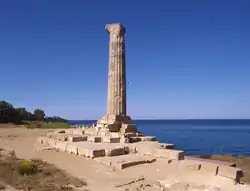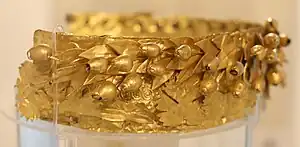Temple of Juno Lacinia (Crotone)
The Temple of Juno Lacinia (as a Roman goddess, originally Hera Lacinia) is a ruined ancient Greek temple and sanctuary dedicated to Hera located on Capo Colonna in Calabria, Italy, near Crotone (ancient Kroton). The main remaining feature is a Doric column with capital, about 27 feet (8.2 m) in height.

The site lies on a promontory formerly called Lacinion in a strategic position along the coastal routes linking Taranto to the Strait of Messina. The venerated goddess, Hera Lacinia, was named after the location.
History

The sanctuary was dependent on ancient Crotone and was one of the most important of Magna Graecia until the 4th century BC.
The date of the erection of the temple is postulated as 480–440 BC.
It was mythically founded by Hercules (Herakles) after he killed the bandit Lacinius, who attempted to steal some of the cattle of Geryon.[1]
The federal treasury of the Italiote League was moved there in the 5th century BC, and remained there until relocated to Herakleia near Tarentum.[2]
Before evacuating Italy in 206 BC, toward the close of the Second Punic War, Hannibal dedicated a bronze plaque inscribed in Punic and Greek there detailing his accomplishments.[3]
In 173 BC, the Censor Quintus Fulvius Flaccus dedicated the Temple of Fortuna Equestris in Rome, for which he had stripped the marble tiles from the roof of the Temple of Juno. In 172 BC, out of grief over tragic news about his sons, Flaccus hanged himself. "[T]here was a general belief that he had been driven mad by Juno Lacinia, in her anger at his spoliation of her temple."[4] The Senate ordered the tiles returned, but, "as there was no one who understood how to replace the tiles they had been left in the precinct of the temple."[4]
Cicero cites Coelius Antipater saying that the temple featured a golden column. Hannibal wanted to know whether or not it was solid gold, and drilled a hole and, determining that it was solid, decided to take it back to Carthage. The next night Juno appeared to him in a dream and threatened him with the loss of his remaining good eye if he took it. Hannibal obeyed the warning; he had a small statue of a heifer, sacred to Juno, cast from the drill shavings and mounted it on top of the column.[5]
The temple was said to have been still been fairly complete in the 16th century, but was destroyed to build the episcopal palace at Crotone.
Description
The temple has been described as "perhaps the most splendid [structure] in southern Italy".
The sanctuary was in an area of forest sacred to the goddess, later surrounded by Roman walls. Hera also protected nature and in particular the cattle which grazed freely within the forest.[6]
The Doric temple had six columns in front (hexastyle) with a total of 48 columns over 8 m high. The roof was made of marble slabs and Parian marble tiles.[7] Architectural fragments were excavated in 1886–1887 by the Archaeological Institute of America.
The sanctuary includes at least three other buildings: "B”, "H” and "K”. Building B is believed to be the original temple due to finds from the 8th century BC. Building H, the Hestiatorion, from the 4th century BC has several rooms and was the canteen and refreshment building for pilgrims and priests when the sanctuary had become famous. Building K, the Katagogion, also from the 4th century BC, is a stoa or portico of Doric columns connecting a series of rooms and a courtyard. In the northern part of the archaeological area is part of a settlement from the Roman era, belonging to the colony of Crotone founded in 194 BC.[8]
The sculptures found were mostly buried again, but a few fragments, some decorative terracottas and a dedicatory inscription to Hera of the 6th century BC, in private possession at Crotone, are described by F. von Duhn in Notizie degli scavi.[9]
See also
References
- DIODORUS SICULUS; Oldfather, Charles Henry (tr.) (1935). "iv.24". The Library of History. Loeb Classical Library. Retrieved Mar 9, 2018.
- Beck, Hans; Funk, Peter, eds. (Oct 31, 2015). Federalism in Greek Antiquity. Cambridge University Press. p. 400. ISBN 978-0-521-19226-2. Retrieved March 16, 2018.
- Fisher, Greg (2016). Hannibal and Scipio. The History Press. ISBN 978-0-7509-6874-4. Retrieved Mar 9, 2018.
- Livy; Roberts, William Masfen (tr.). Ab Urbe Condita. p. XL.28.
- Cicero, Marcus Tullius; Yonge, Charles Duke (tr.) (1853). On Divination XXIV. London: H. G. Bohn. p. 165. Retrieved Mar 9, 2018.
- Museo e Parco archeologico nazionale di Capo Colonna https://musei.calabria.beniculturali.it/musei?mid=83&nome=museo-e-parco-archeologico-nazionale-di-capo-colonna
- Livy xlii.3
- Museo e Parco archeologico nazionale di Capo Colonna https://musei.calabria.beniculturali.it/musei?mid=83&nome=museo-e-parco-archeologico-nazionale-di-capo-colonna
- von Duhn, F (1876). "Cotrone — Antichità greche di Crotone, del Lacinie e di alcuni altri luoghi del Brezio". Notizie degli scavi di antichità. 1897: 343–384. Retrieved Mar 16, 2018.
- See R. Koldewey and O. Puchstein, Die griechischen Tempel in Unteritalien und Sicilien (Berlin 1899, 41).